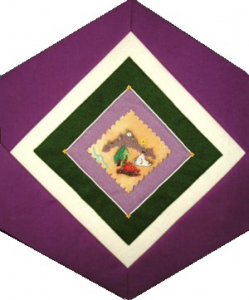Sekani

The Block
Mabel and Elsie Pierre drew on their knowledge and skill of traditional-style beading to create a landscape scene typical of their Sekani homeland. Worked on a section of moose-hide the beading depicts the lavender mountains, forest, teepee and fire. The two rows of blue beading, on the left, represent the Finlay and Ingenika rivers that historically provided a wide variety of fish, including Kokanee salmon, trout and Dolly Varden (a type of Char). The soft colour of the hide is contrasted against a dark lilac wool backing, framed by a single line of white beads highlighted at the corners with yellow and orange details
Cultural Profile
Located in east-central British Columbia, the Sekani Tsey Kenneh (People of the Mountain) used the Finlay travel routes. Their traditional territory included the entire Finlay River basin. The Sekani were the first Aboriginal people encountered by Alexander Mackenzie in British Columbia, on his travels to the Pacific in 1797.
The Sekani fished for trout and Dolly Varden, relying also on the abundance of wild game for their main food supplies. This included bear, moose, beaver, porcupine, rabbits, caribou, deer, wild goats and sheep. One interesting Sekani method of hunting was to chase animals along paths lined with walls of twisted branches into a corral.
At one time the Beaver and Sekani were one group but a falling out caused a separation. The two groups share the same root language and have somewhat similar customs. Following the separation, the Sekani retreated into their ancestral homeland avoiding, as much as possible, contact with more war-like neighbouring tribes. They did some trading of pelts with other tribes, particularly the Carrier.
The Sekani believe everything serves a purpose, and take pride in ensuring nothing is wasted. Clothing was made from the furs of the beaver, groundhog (marmot) and fox, and for winter, the wolf. Groundhog skins pieced together were made into blankets, and moose-hide into sturdy moccasins. Traditional medicinal herbs continue to be gathered and used today, the knowledge of their use passed on by community Elders.
Sponsor: Kathleen Alguire
